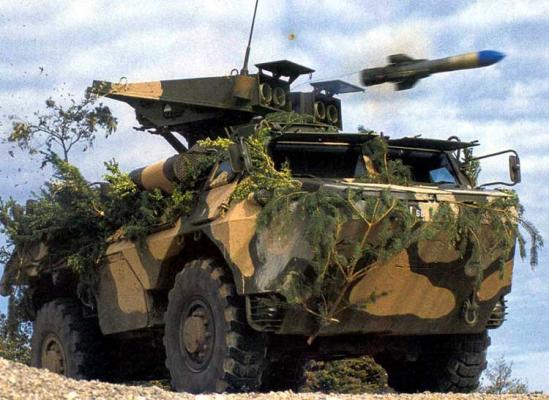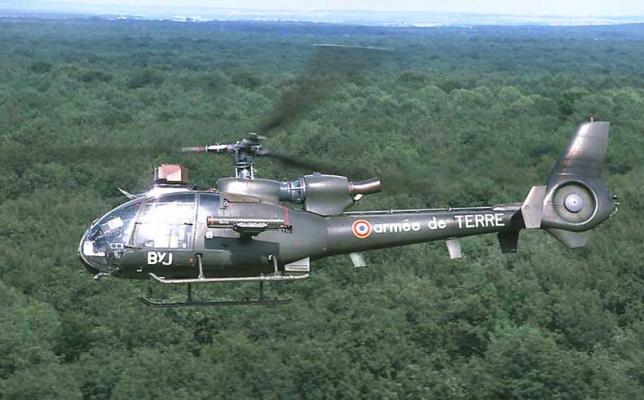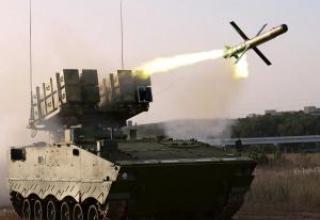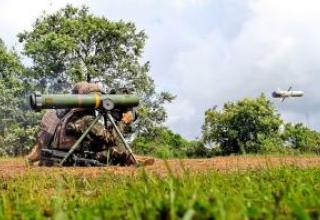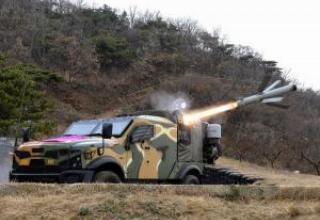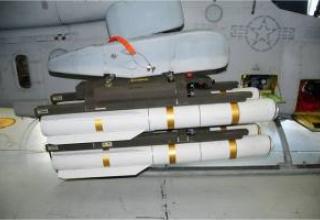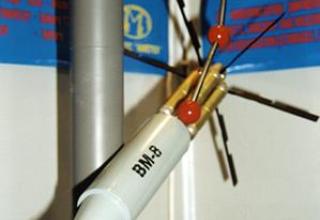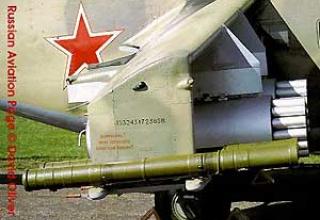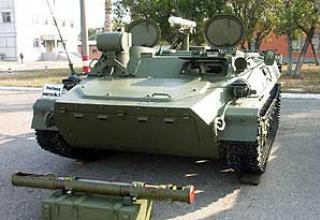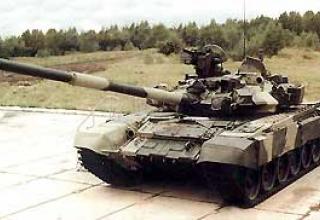The Haut subsonique Optiquement teleguide tire d'un Tube (Haut subsonique Optiquement teleguide tire d'un Tube), a heavy French-German anti-tank missile system, is used for arming combat helicopters and placement on self-propelled chassis. It was developed by the Euromissile consortium (MBDA France and LFK) on the basis of HOT APC and adopted for service in 1974.
The "HOT" complex is designed for the armament of mobile vehicles (cars, drums, helicopters) and for stationary underground installations (strongholds, fortified areas). The main features of the "NOT" complex: compactness, the possibility of quick replacement of the complex elements in case of their failure, automatic charging, high rate of fire, large ammunition of missiles.
The "NOT" complex is capable of engaging highly mobile targets mounted on vehicles of different classes of armoured and unarmoured, on platforms, platforms and helicopters; it ensures combat operations both on the offensive and in defensive battles, and fires at a distance of up to 4000m. In defense, the PTWC is able to destroy enemy tanks before they open fire and defend against enemy air attacks by helicopters and aircraft flying at low altitudes.
The complex has been repeatedly upgraded and adapted to different carriers. Various modifications of the complex were widely supplied for export - now the PTRK "NOT" is in service with 19 armies of different countries. Since the beginning of serial production, about 85 thousand missiles, 820 self-propelled air defense missile systems have been produced and the complex is equipped with about 720 attack helicopters. Since 1998 the firm-manufacturer offers the last option, which received the "HOT-3".
Composition:
The complex consists of:
- PTUR,
- trigger device,
- computer control equipment
- equipment for rocket testing and maintenance.
The missile (see diagram) consists of a two-stage RDTT (launch and march), a combat unit, an autonomous compartment with guidance system elements and stabilizers. The missile's combat unit (weighing 6 kgf) includes: a cumulative charge (weighing 3 kgf), a pyrotechnic fuse of instantaneous action, an electric detonator triggered by deformation of the front tip at almost any angle and a safety device that comes into action when the missile flies from the PU 30-50 m. The launch engine, on the axis of which the gas pipe of the marching engine passes, has 4 lateral inclined nozzles, is able to develop PTUR speed on a trajectory up to 260 m/s less than 1s after the launch. The marching engine has a thrust equal to 500 kgf.
The autonomous missile control compartment includes:
- A thermopile providing the rocket board with electricity and starting to operate by triggering a pyrotechnic switch, which is at the same time a fuse for storing the rocket in a warehouse for 5 years;
- a decoding device that receives and amplifies the guidance system signals transmitted by wires, processes them and transmits them to elements that change the direction of the thrust vector to correct the missile's trajectory and provides stabilization of the missile in flight;
- a modulated stabiliser that performs control functions after the missile is launched until the missile has reached the required speed;
- a gas-jet control device designed to hold the missile in line of sight by directing the gas jet at the rudder, which operates synchronously with the rotation of the missile;
- a reel (mounted on a marching engine tube) with a wire to transmit control commands. The wire during the flight of the rocket is removed from the coil;
- Infrared signal system consisting of daytime (with very bright flames) and nighttime (with less intense flames) trackers.
The rocket is launched from a fibreglass reinforced plastic transport and launch container. The operator points the crosshairs of the sight at the target and presses the start button. In this case, in a very short time, the thermal battery is activated, the gyroscope is launched, the tracer is lit, the starting engine comes into action and the rocket leaves the TPK. After passage 30-50m from PU the fuse operates and the fuse is blown; less than for 1c the rocket gains speed 250 m/s (this speed on a trajectory is supported by the traction of the marching engine). The operator continuously holds the telescope sight crosshairs on the target. The IR tracking system keeps the missile on the sighting line. When the missile deviates from the sighting line, commands generated by electronic equipment are transmitted via wires to the missile. The received commands are decoded on board and transmitted to a device that controls the thrust vector. All operations to point the missile at the target are performed automatically.
The following versions of the missile are developed as part of the "HOT" PTWC
- "HOT-2" (1985) with cumulative BC. The BC caliber was increased from 136 to 150 mm, new BB (octolite) of 4.1 kg weight was used in BC, which allowed to increase armor penetration.
- The "NOT-2" with multi-purpose BC is designed to combat various targets and has as ready-made hitting elements - steel balls located around the cumulative charge, as well as chemical components to ensure ignition effect.
- "HOT-3" (1998) is equipped with a new noise-proof bi-spectral tracking equipment operating in the range from 1 to 10 microns. The combat unit is tandem with a detachable precharge, which provides an increase in time delay between detonations of charges to overcome the dynamic protection. The BC is equipped with a laser detonator.
For the maintenance of the complex there are three types of MIS: MIS of the 1st echelon is designed to check the serviceability of the PU by the method "working", "not working". The rocket, packed in a hermetic container-tube, does not require inspection before launch; ZIP of 2nd and 3rd echelons is designed to adjust and check the correct position of the IR tracking system axis and the launch direction axis relative to the optical sighting line, as well as checking individual system elements for their replacement. The IR sighting system is transported on conventional vehicles used in military units.
For preparation and training of operators of "NOT" complex the training equipment consisting of firing simulators simulating rocket flight and its hitting in movable or stationary targets (targets) of different shapes and installed at different distances is used. Television installations are used to monitor the accuracy of aiming and to detect the magnitude of errors by the instructor.
The "NOT" complex can be placed on a large number of combat vehicles, ranging from light aircraft used in airborne troops to heavy tanks.
Placing "HOT" APC on helicopters provides a combination of high firepower, maximum mobility of the whole system and optimal range (up to 4300m). In addition, the lift of the helicopter to heights of 10, 20 and even 30 meters solves the problem of finding the optimal position, usually encountered in front of ground vehicles. The design of the complex allows its installation on different types of helicopters up to the lightest. The number of PU installed on helicopters depends on the helicopter model and can be 2.4 and 6. Complex "NOT", installed on the helicopter ВО-105, has 6 PU (3 on each side), stabilized sight is connected with the IR-system of escort. French SA.341F "Gazelle" with two missiles "HOT" on each side is in service since 1979. The guidance system is stabilized and equipped with a sight mounted on the roof of the helicopter. At present, the guidance system is upgraded and provides firing of new HOT-3 missiles, including at night. The upgraded version received the designation "Gazelle HOT/ Viviane". Viviane" system is developed by "MBDA France" and has a sighting system with 19x and 38x digital zoom, which provides display of all information on the display screen. HOT" is also part of the new EADS/Eurocopter "Tiger" helicopter.
The French self-propelled Mephisto is based on the VAB wheeled armored personnel carrier on which a set of sighting and launching equipment designed for the HOT is installed. It includes a rising armored platform of circular rotation with four guides for launching missiles, periscopic telescopic sight with variable magnification (3- and 12-times), control equipment, electric guidance drives and a gun mount for eight "HOT-2" APCs, located at the rear of the combat compartment. To move the launcher to a hiking position, the platform shall be lowered down. In 1992 the platform is lowered down. Mephisto" APC was modernized by installation of night vision with IR-electronic-optical converter (6x magnification), in 1997. - It was adapted for use of noise-proof bi-spectral tracking equipment of PTUR "HOT-3".
German self-propelled PTUR "Jaguar-1", which is equipped with anti-tank companies of motorized infantry brigades (12 launchers each), has been in service with the Bundeswehr since 1978 (316 units in total). It is a self-propelled "Jagdpanzer" launcher on which the "HOT" anti-tank firing equipment is mounted. The machine body at the front is reinforced with additional armour plates. Flatbed screens are also installed. The sighting and launching equipment includes variable magnification telescope sight (4- and 12-fold) and control equipment, as well as a compact turret, which is equipped with a mechanized warhead for eight "HOT" PTUR, retractable guide with a device for discharging the empty transport and launching container and automatic charging mechanism. The rest of the ammo set (12 missiles) is located in the combat compartment of the unit. Thanks to the automatic recharging the speed of the complex reaches 3 rpm. The Jaguar-1 self-propelled air defense system is also armed with two 7.62 mm machine guns. One of them is in a ball bearing next to the driver mechanic, and the other - on the turret of the commander's turret.
The company "GIAT Industries" has developed a two-seater tower "Lancelot" weighing 1.8 tons, with four rails for PTUR "HOT" and 7.62mm machine gun. The tower accommodates the commander of the combat vehicle and the operator of the ATV. The "Lancelot-3" version is equipped with an M-427 laser rangefinder. "Lancelot" includes a sighting optronic system and IR tracking system, has hydraulic drive and automatic charging system. At the operator's disposal is an M-509 sight with 3-12x magnification. The commander uses a laser rangefinder and a sight with 8.3x magnification. There is a thermal sight for night shooting. The "Lancelot" can be installed on the chassis of "Jaguar", "Mowag-Piranha", AMX-10.
The firm "Euromissile" has developed and produces for export the universal PU "UTM 800" of rotating type weighing 900 kg, which can be mounted on any combat vehicle, allowing to place the epaulet of 800 mm diameter (such as "Pandar", VAB, etc.). For placement on light chassis such as "VBL", "Wiesel", etc. the same company offers ATM fire module with guides for two missiles, equipped with all necessary sighting systems and laser rangefinder. The module allows to fire "HOT-2" and "HOT-3" missiles and can be additionally equipped with a 20 mm gun.
German experimental self-propelled PTRK "Panther" is based on all-wheel drive vehicle with cross-country ability (8x8). At the 12.5-meter height mast is equipped with an operator's cabin with six PTUR "HOT", as well as sighting devices. Additional ammunition consists of 12 missiles. There is no data on the adoption of this complex.
Characteristics:
| Range of fire, m | 75-4000 |
| Maximum flight speed, m/s | 250 |
| Average flight speed, m/s | 235 |
| Missile flight time at a range of 2000 m, s. | 9 |
| Missile flight time at a range of 4000 m, s. | 17.3 |
| Speed, gunshot/min. | 2-3 |
| The length of the rocket, mm | 1270 |
| Missile launch weight, kg | 29 ("HOT-1"), 32 ("HOT-2"), 33 ("HOT-3") |
| Mass of the rocket in the TPC, kg | 32.6 |
| Weight BC, kg | 6.5 |
| The length of the rocket, mm | 1275 ("НОТ-2") 1300 ("НОТ-3") |
| The diameter of the rocket, mm | 136 ("HOT-1"), 150 ("HOT-2","HOT-3") |
| Armor-piermeable, mm | 1300 ("HOT-3") |
Testing:
During the war with Iran, Iraq used HOT missiles, launching them from ground armored vehicles as well as helicopters. In the 1980s. "HOT was used in Lebanon by Syrians who destroyed several Israeli tanks such as Merkava. The complex was used by multinational forces during Operation Desert Storm.
Sources:
- Вооружение и техника. Справочник, 1982г
- Военная техника. выпуск №12, 1972г
- International Defense Review,№6, 1975г
- "Hot" /"ixarm"-armaments portal
- "Hot" anti-tank weapon system / army-technology.com
- Raketenjagdpanzer Jaguar 1
